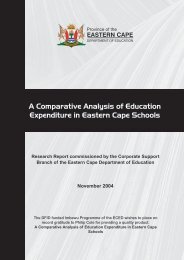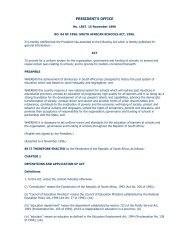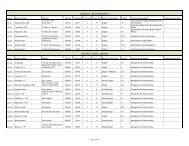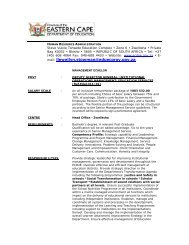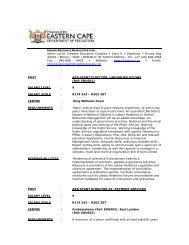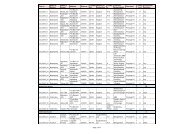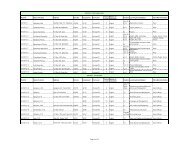part a: strategic overview - Department of Education
part a: strategic overview - Department of Education
part a: strategic overview - Department of Education
You also want an ePaper? Increase the reach of your titles
YUMPU automatically turns print PDFs into web optimized ePapers that Google loves.
The obvious group <strong>of</strong> small schools where re-organization is to take place is that <strong>of</strong> farm<br />
schools. Here a number <strong>of</strong> schools that have become unviable have already been<br />
amalgamated or closed down.<br />
15.3.3 Maintenance and Refurbishment<br />
Major maintenance and refurbishment are also undertaken at all schools where additional<br />
accommodation is being provided under the capital works programme, while minor<br />
maintenance is carried out by the school itself (Section 21 schools) or by the District Office on<br />
behalf <strong>of</strong> the school (Section 20 schools) – note that funds for minor maintenance are not<br />
channeled through the infrastructure budget.<br />
However, the condition <strong>of</strong> many <strong>of</strong> the De<strong>part</strong>ment’s buildings is such that significant repair<br />
and renovation is required, as is evident from the table below:<br />
Table 47:<br />
1: Condition <strong>of</strong> Capital Stock (April 2005)<br />
Condition Number %<br />
Very Weak (mud) 939 12.5<br />
Weak 3,148 41.9<br />
In Need <strong>of</strong> Repair 2,207 29.4<br />
Good Condition 963 12.8<br />
New Building 52 0.7<br />
Being Upgraded 201 2.7<br />
No Response 0 0<br />
TOTAL 7,510 100<br />
Note that the table above includes all ECDoE facilities and not just schools.<br />
All schools have been categorized according to well defined needs in the <strong>Education</strong> Facilities<br />
Management System (EFMS). It is the De<strong>part</strong>ment’s endeavour to introduce a cyclic<br />
maintenance programme as <strong>part</strong> <strong>of</strong> its increasing focus on life cycle planning / costing. This<br />
will, however, require significantly more funding than is currently the case. Maintenance<br />
currently accounts for approximately 15% <strong>of</strong> the budget, and this will need to be increased<br />
substantially. Unfortunately the extent <strong>of</strong> the backlogs places a greater demand on the budget<br />
at present.<br />
15.3.4 Asset Management Plan<br />
The De<strong>part</strong>ment’s Physical Resource Planning section has prepared a 10-year asset<br />
management plan (known as the Infrastructure Plan) for the period 2005-2014. This sets out<br />
the current infrastructure situation, proposed levels <strong>of</strong> service, principles for provision <strong>of</strong><br />
facilities, and plans for intervention. The policies and strategies contained in this Strategic<br />
Plan are in turn reflected in the Infrastructure Plan where these affect physical infrastructure<br />
in any way.<br />
The Infrastructure Plan, <strong>of</strong> which the first edition was only produced in 2005/06, is in the<br />
process <strong>of</strong> progressive sophistication. Initially it was in effect only an annual project list, but<br />
now endeavours to cover the entire infrastructure life cycle. This implies a much stronger<br />
focus on post construction aspects such as operational costs, maintenance, rehabilitation and<br />
ultimately disposal. The establishment <strong>of</strong> the EFMS was the first step in this process. Other<br />
current activities include<br />
� the introduction and implementation <strong>of</strong> best practices in infrastructure planning and<br />
delivery (through the Infrastructure Delivery Improvement Programme (IDIP), and<br />
� broadening the base <strong>of</strong> Implementing Agents employed for infrastructure delivery and<br />
strengthening <strong>of</strong> the performance agreements with these agents.<br />
The De<strong>part</strong>ment now has formal Service Level Agreements with the De<strong>part</strong>ment <strong>of</strong> Public<br />
Works, the Independent Development Trust, the Amatola Water board, and Eskom. It is also<br />
5 Year ECDoE Strategic Plan for 2005/06 to 2009/10. March 2006 Page 98<br />
5 Year ECDoE Strategic Plan for 2005-06 to 2009-10. 21 F (5) Page 94<br />
<strong>part</strong> C: background information




